Starting a business is difficult in itself. Making it grow is a totally different box of frogs. But a great way to start is to improve your ecommerce customer service.
But how to step up your online store’s customer support?
Right here.
Stick around and discover how to delight your shoppers with excellent service and increase your sales.
Level up your customer service with a world-class ticketing system
From the top—
Let’s understand what an ecommerce support is in the first place.
What is ecommerce customer service?
Ecommerce customer service is a way for online businesses to provide shopping assistance and a seamless customer experience across different channels and platforms. It involves everything from solving customers’ problems to helping them make the right purchasing decisions.
And good online customer service essential if you want your business to thrive—over 95% of consumers say that customer service is important for their brand loyalty. But it’s not enough just to offer customer support, you need to provide great customer service to attract and retain online clients. This is because bad customer service can cost you up to 96% of your buyers.
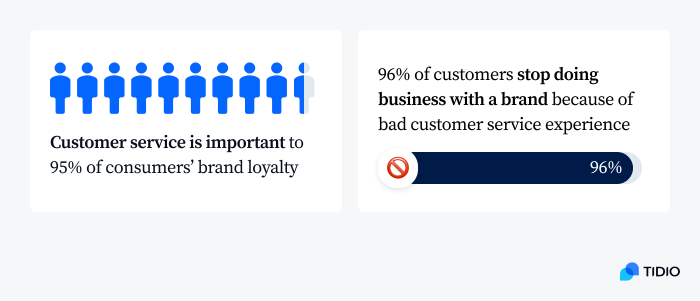
Customers have higher expectations than before. That’s a fact. But they also experience more difficulties. So, to avoid getting disappointed with customer service, shoppers move to brands that offer quick and knowledgeable support. In fact, about 58% of American shoppers would pay more if they knew they would receive great customer service.
Seems like price isn’t the most important aspect of shopping after all.
How is ecommerce customer service different from brick-and-mortar assistance?
The main difference between ecommerce customer service and the one provided in brick-and-mortar stores is the lack of face-to-face interactions.
Retailers in physical stores can build rapport and trust through direct interactions. They can offer personalized assistance and turn one-time shoppers into loyal customers. Online retailers need to get a little more creative to get the same results, as many consumers might feel like their shopping experience is impersonal.
However, online stores have something physical shops lack—they provide a higher convenience for customers who can shop anywhere, at any time. And ecommerce websites should take advantage of that.

For example, a shopper comes home after a whole day on their feet and remembers that they need to get a new bag as their old one is worn out. They don’t want to move and drive to the mall. It’s much more convenient to browse through online shops.
If you provide chatbots and live chat, website visitors will receive a personalized experience from their own virtual shopping assistant.
It’s a win-win situation, don’t you think?
Delight shoppers with excellent customer service on your ecommerce site
Read more: Check out how eye-oo, a multibrand ecommerce store, increased their revenue with the help of AI-powered customer service.
Customer service issues in ecommerce
Let’s face it—lack of in-person interactions is not the only issue online businesses have when it comes to providing customer service. And it’s also not the only matter that shoppers are frustrated or disappointed with.
Some of the major issues that cause bad ecommerce customer service experience include:
- No change being implemented after negative feedback is provided—81% of buyers
- Having to explain a problem to multiple people—72% of shoppers
- Long time on hold—66% of customers
- Rude representative—49% of clients
- Unknowledgeable employees—46% of customers
- Not being able to reach a human representative—30% of consumers
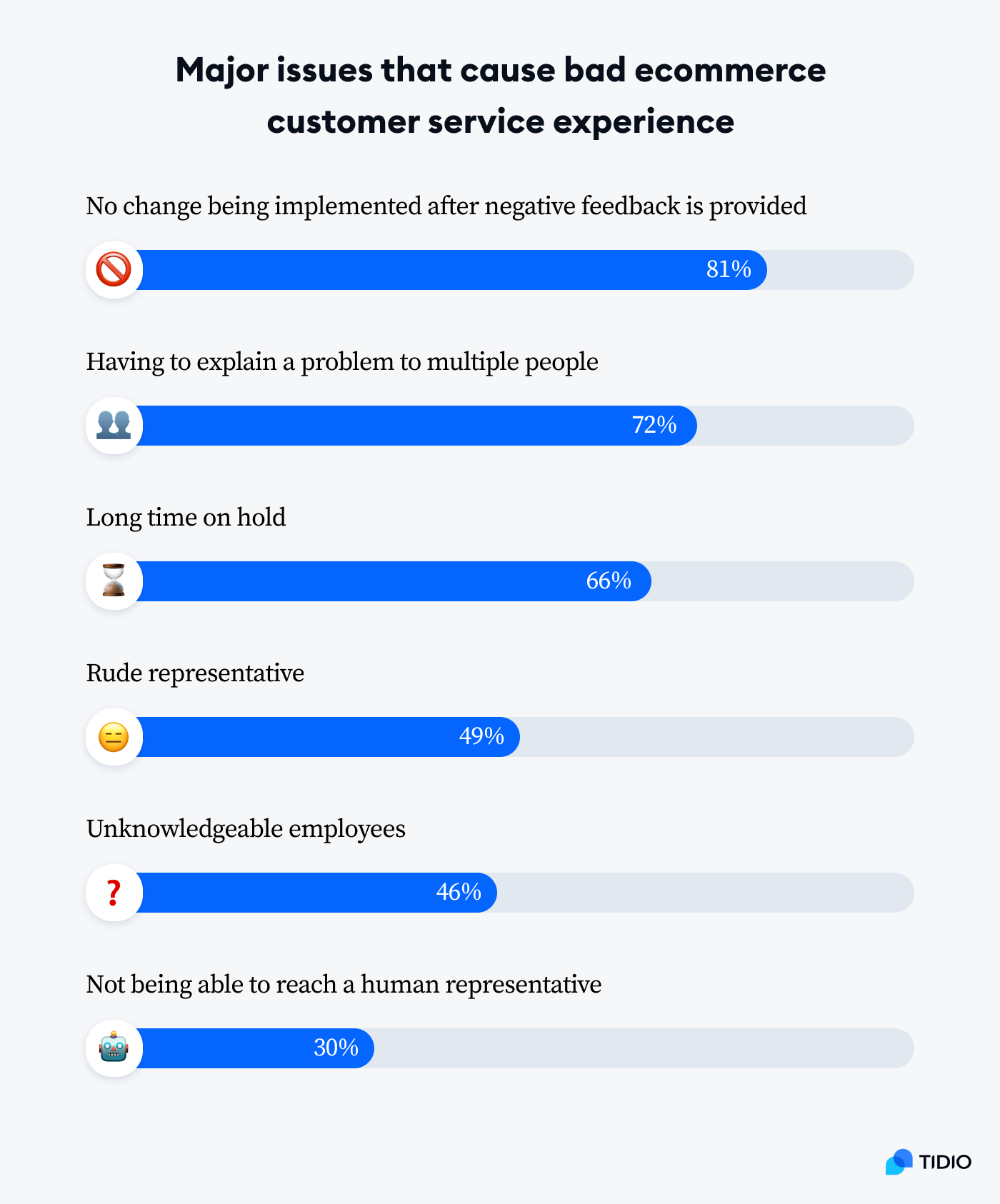
Read more: Learn more about bad customer service with examples and how to fix the issues.
Importance of customer service in ecommerce
Is it even worth the effort and investment? Yes, it is. But don’t trust our word for it. Instead, let’s look at some studies and statistics that show why ecommerce customer service is so important for your business.
- It improves customer experience
Ecommerce customer service can boost the experience shoppers have with your brand and personalize the interactions you have with your clients. And that’s more important than you might think.
Especially since about 71% of consumers are frustrated because of the impersonal shopping experience. Personalized shopping experience ranges from customized emails to product recommendations that are specific to the client. Whatever your ecommerce help provides, personalization of interactions can really go a long way in setting your brand apart from the competition and lead to the ideal customer experience.
Read more: Learn all about key customer service statistics and get informed about the latest CX trends.
- It increases sales
The hard truth is that even if you offer great products and premium deals, the shoppers can leave you after one bad experience with your ecommerce support.
So, it’s really worthwhile to work on the service provided by your front-line support reps. It can bring you quite a large sum in revenue. In fact, satisfied customers spend 140% more than unsatisfied shoppers.
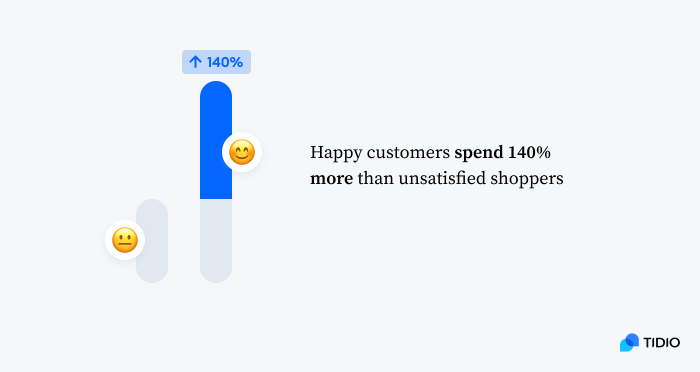
To put it in perspective, an unhappy buyer will spend $20 whereas a happy one will leave $48 on their visit to your store. If you multiply it by 100 customers who walk through your virtual door, you’ll get an additional $2,800 from their purchases just because of a good ecommerce service experience.
- It helps to retain customers
Here’s the deal—acquiring a new customer is much more costly than keeping the current one. And know that one of the main factors that drive shoppers away is poor client support by the ecommerce help agents.
Research found that increasing customer retention by 5% can boost profits up to 95%. On top of that, repeat clients are shown to spend on average 67% more than first-time buyers.
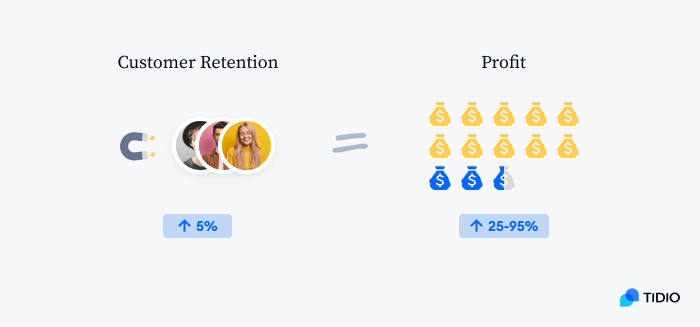
- It provides free referrals
Do you know what your shoppers are saying about your brand online? You should—word of mouth is a powerful thing.
Humans are social creatures and listen to the opinions of others. They also very often form customer expectations and make decisions based on what they hear. In fact, about 88% of buyers read online reviews in order to determine the quality of a brand. So, make sure the opinions about your business are on the positive side.
- It builds trust in your ecommerce website
People’s trust can make or break your business. This was shown in a study which found that over 49% of US consumers increase their purchases from a brand they trust. On top of that, 33% of shoppers paid a premium price for trust. Whereas, about 44% of customers stopped doing business with a company because they were lacking trust in the brand.
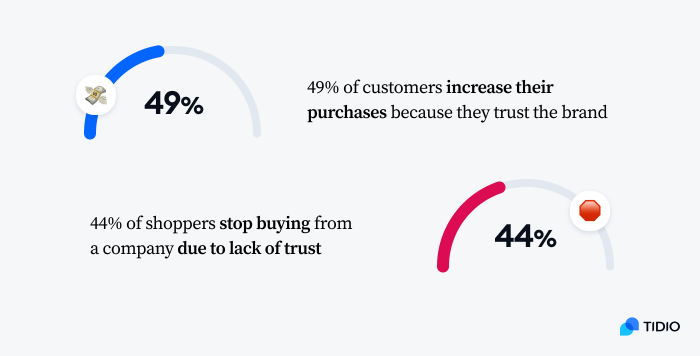
How to get people to trust you? Provide great customer service and let people speak about your brand’s quality and trustworthiness. Your valued clients will refer friends and family, which will increase trust in your business and improve your reputation.
Read more: Learn more about why customer service is important for your business.
Okay, so how to fix your ecommerce support to enjoy all its benefits? Let’s go through some of the best practices to accomplish that.
How to improve customer service in ecommerce?
Since you know how important good customer support for ecommerce stores is, you should strive for it. But how to do it?
Well—
Here are the top 10 ecommerce customer service best practices you can use to improve your client support.
1. Provide multichannel communication
A multichannel customer service means that a company communicates with its shoppers via a variety of platforms, such as website chat, email, social media, and phone calls.

Being available to your customers on multiple channels and platforms can help you delight the shoppers and improve their experience. In turn, this will improve the trustworthiness of your online store and boost your revenue.
Isn’t it easier to contact a business and solve your problem straight from their website or social media instead of dedicating 30 minutes to being on hold with the company? Of course, it is! That’s why so many customers enjoy the live chat and chatbots available on multiple platforms and communication channels.
2. Be available 24/7
Being an ecommerce brand, you should keep in mind that your customers browse your store at any hours of the day and night. And if they come across any issues or need assistance, you should be there for them.
So, to truly improve your customer support, implement chatbots and provide a 24/7 virtual assistant to all of your shoppers. This way, you are available whenever the visitor needs you, without having to spend thousands of dollars on additional staff.

Read more:
- Discover what the best chatbot platforms are to choose the right one for your business
- Learn how to create a chatbot for your website in less than 5 minutes
3. Train your ecommerce customer service representatives
Some people are naturals when it comes to providing excellent commerce customer service. However, most of your support representatives need to put in the work to provide high-quality support. Exceptional ecommerce service is a skill, and it can be learned through training and practice.
Therefore, you should provide proper training to your customer support agents, like peer reviews, role-playing, and crisis management exercises. This will level up your service and help your employees grow. In turn, you’ll see greater results and your employees will be happier in their job.
4. Enable self-service
Customer self-service can include a knowledge base, forums, FAQs, and a chat widget on your site. This is a way to provide support to your shoppers without the need to involve the customer service representative. What’s more, 90% of customers expect online businesses to have a self-service portal. A self-service customer portal allows customers to access information, manage their accounts, and find answers to common inquiries on their own, empowering them with convenience and control over their interactions with the business.
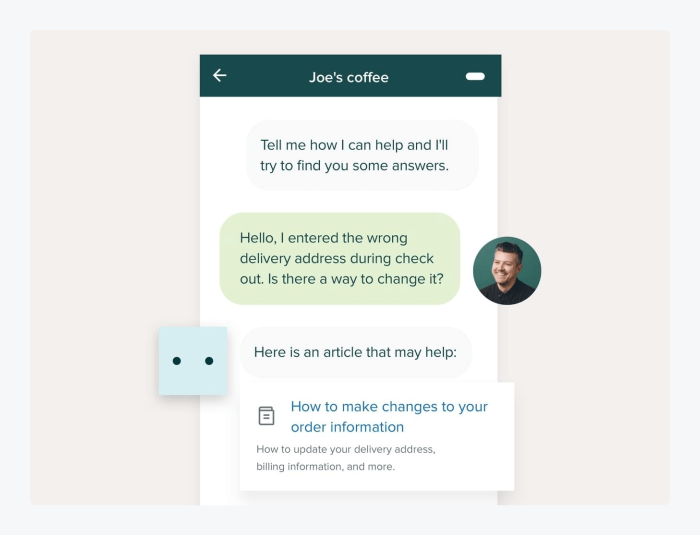
So, it’s in your best interest to spend a few days organizing instructions, preparing guides, and collecting answers to frequently asked questions in one place for your buyers to easily find what they need. You will need to keep this information updated, but it is worth the effort to improve customer experience and get some queries off your representatives’ shoulders.
5. Personalize your customer interactions
As we already mentioned, personalization is important to keeping your shoppers happy and building customer loyalty.
Think about it—isn’t it nice when an employee at Starbucks knows your name before you say it? It builds a relationship and encourages you to come back.

So, make your communication with clients more personal and human to ensure they feel good interacting with your ecommerce customer care team. Bottom line—we are all human and want to be treated this way. Nobody appreciates feeling like a number in a queue for an ecommerce customer service call center.
Read more: Learn all you need to know about customer relations, its importance, and benefits.
6. Collect customer feedback
Who do you think knows best what needs improvement in your company?
That’s right—your customers.
Therefore, you should ask for and collect customer feedback in order to improve your future business decisions. You can discover issues that never occurred to you, measure customer satisfaction, and quickly improve act on the arisen issues.
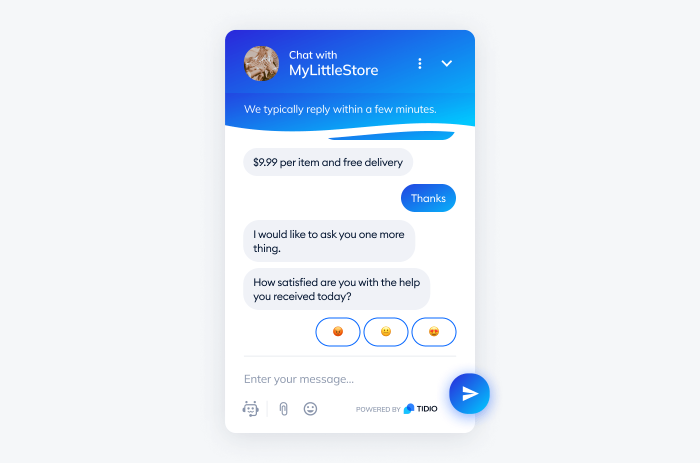
One way of collecting opinions about your ecommerce customer support is to embed customer satisfaction surveys at the end of each live chat interaction. This way, the experience is fresh in the client’s mind, and they can quickly rate your representatives’ performance.
7. Offer proactive customer service
Being reactive in your client support just isn’t enough anymore. You need to reach out to your shoppers to meet their expectations. But don’t be pushy while you’re at it. Make sure to subtly let the buyer know you’re there for them if they need help, assistance, or just want to express their opinions.

You can provide proactive customer service with a chat widget that welcomes customers and asks if there’s anything they need support with. Another option is to send emails to your shoppers to keep them updated and let them know you’re open to a conversation.
8. Respond to queries faster
If you can help it, try to speed up the response rate to your customers’ queries. This will get you more sales and improve the client’s opinion of your business.

Let’s say a potential customer visits your website, and they like one of your pair of trainers. They’re ready to order, but would prefer the shoes in blue instead of red. So, the visitor messages your support and waits for an answer. After five minutes of not hearing back from you, the shopper leaves your store to look for blue trainers at your competitor.
You just handed over your sale to a competitor because of your slow response times. And this could have easily been avoided by implementing chatbots and decreasing response times to mere seconds.
9. Stay on top of your data
When you collect customer feedback and get information about your customers, you should keep them all in one place. It’s important to stay on top of your customer data because it’s the fastest way to spot when something goes wrong. You can quickly catch the slip and improve the inconvenience before it becomes a problem.

One way to do it is to create dashboards for customer success metrics and KPIs (key performance indicators) to keep track of your results. If they’re going the right way, perfect. If the numbers aren’t what you need them to be, you can implement actions and explain to your representatives what they need to do and how.
10. Use tools to improve the quality of service and stay organized
Everyone needs a helping hand sometimes. Especially when it comes to providing exceptional ecommerce service while scaling up a business. Some of the most popular ecommerce customer service software you can use for your business include:
- AI chatbots
- Live chat
- Helpdesk system
- CRM databases
- Social media integrations
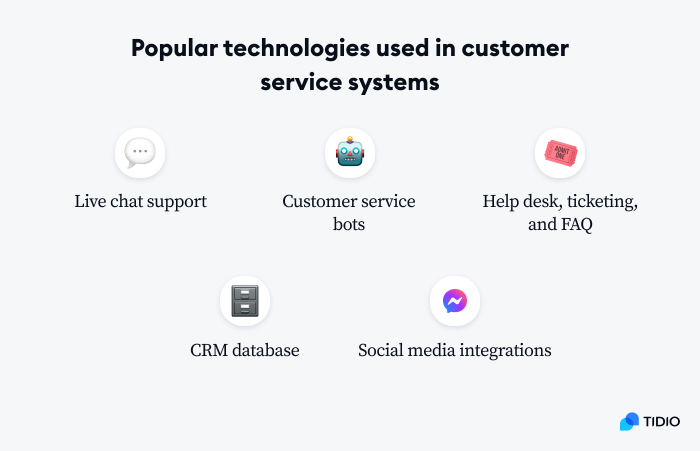
These will help you streamline your ecommerce support. You can use them to be present and meet customers wherever they are, organize your customer communications, and provide self-service for common queries. This way, you can truly focus on growing your business and managing the important processes.
Okay—but are there any online stores you could take as an example of how to provide an exceptional customer service experience?
Best customer service in ecommerce
What are some examples of companies that just do it well? They can include fast response times, knowledgeable representatives, and even free shipping. All these actions can help you to delight the client, improve their experience with your brand, and help to increase your customer service quality.
Here are some great examples of ecommerce customer service:
Zappos

Zappos is an ecommerce retailer that started by selling shoes and expanded quickly into clothing and accessories thanks to large numbers of sales. This company takes “going the extra mile” for the customer to a whole new level. But because this is the standard they set, you should take them as an example and match their level of service.
The business offers free shipping, a clear ecommerce return policy, and captures the local culture in the shopping experience by hiring only local representatives. As part of Zappos’ philosophy, most of the money that would normally go for advertising is channeled into customer support team instead. This way, the company focuses on customer retention instead of acquisition. This approach has earned them many loyal customers.
Some customers even call Zappos “Happiness in a box” and that’s the best advertising you could ask for.
Moda Operandi

This online luxury retail brand offers high-end items. It provides personal stylists that can make the clients feel like models on a runway. It also offers a post-runway shopping experience after its online shows to engage more shoppers.
Moda Operandi has nearly 8,000 positive customer reviews with over 6,000 excellent ratings on Trustpilot for their exceptional ecommerce customer service. Their high-quality service, including fast delivery, good packaging, and prompt responses from the support team, delights shoppers and encourages them to return for more.
Swanson Vitamins

Swanson Health Products started as a mail-order business. With some time, it has become one of the top global commerce businesses. It focuses on selling vitamins and other health supplements from its online store.
This company became the gold winner in the Customer Service Department of the Year category in 2021. It provides a fast response time for email and phone calls, as well as a year-long return policy for the products. This is one of the reasons this ecommerce business is growing while others fail.
Don’t worry if you’re not there yet—
Even if you don’t have the budget to hire more customer service agents, you can still upscale your customer service. You just need to put it on autopilot.
How to automate ecommerce customer service?
Whether you’re struggling with too many phone support calls or can’t process refund requests quickly enough, you could use some support tools and get processes off your back. Automating your live support can help you with follow-up emails and smoothly push the shopper down their customer journey. And you can also add a pleasant omnichannel experience to your customer service strategy.
Some of the ways to automate your ecommerce support:
- Automatic ticket assignment
Create rules for your ecommerce help desk tickets to be assigned to specific agents. These rules can be based on the agents’ knowledge areas or in order of last resolved inquiry. Automating ticket assignment is a good way to save your customer service team some time and make the process fair so that everyone gets the right number of tickets assigned to them.
- Canned responses
These are pre-written messages you can use to answer the most common questions. This way, when the representative receives common customer requests, they can select and personalize the canned response quickly. It allows them to provide concise information within a few seconds instead of the minutes that would take to type it all out.
- Self-service widgets
Chat widgets are almost like putting your knowledge base on all of the pages on your online store. They are a point of entry to your help desk, can direct the visitor to the right guide, and answer any frequently asked questions automatically.
- Chatbots
How chatbots will change ecommerce customer service depends on the rate of adoption, but they’re already transforming the way retailers create customer experiences. Chatbots scan and interpret incoming messages to simulate a human conversation. This way, they assist the client and solve common customer support queries in a natural way.
Read more: Learn all you need to know about customer service automation and how to use it for your ecommerce business.
So, what tools can you use to automate and improve customer service?
Best customer service software for ecommerce
| Tool | Rating | Free plan | Best for |
|---|---|---|---|
| Tidio | 4.7/5 ⭐️ (1,175+ reviews) | ✅ | Small to medium businesses |
| LiveChat | 4.5/5 ⭐️ (735+ reviews) | ❌ | Analytics |
| Gorgias | 4.6/5 ⭐️ (420+ reviews) | ❌ | Order management |
| Yieldify | 4.7/5 ⭐️ (110+ reviews) | ❌ | Personalization |
| Yext | 4.4/5 ⭐️ (290+ reviews) | ❌ | Search features |
Here are the best ecommerce customer service tools you can use to improve your support and customer experience:
1. Tidio
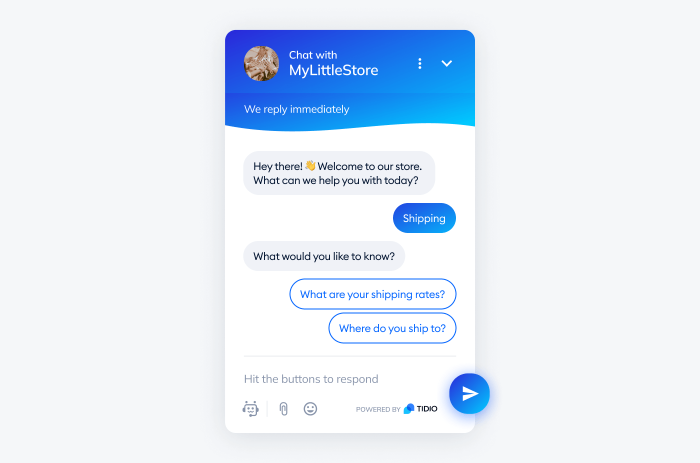
Ratings: 4.7/5 ⭐️ (1,175+ reviews)
Yes, this is our product, but hear us out.
We won’t be promoting ourselves in this article as this is not the right place for it. Instead, we would like to encourage you to check out our ecommerce customer service tool free of charge. Look through our users’ reviews and let us know if we deserve this spot on the list.
A quick introduction—Tidio is an all-in-one customer service software for online businesses. It includes live chat, chatbots, and a shared inbox for all of your customer communications. You can put it on your website without any coding skills and in less than two minutes. It helps you with customer interactions, saving abandoned carts, marketing your products, and much more.
Main features:
- Canned responses
- 20+ chatbot templates
- Live-typing feature
- Real-time visitor view
- Variety of ecommerce integrations (Shopify, Zapier, MailChimp, Facebook Messenger, and many more)
- 7-day free trial available
- Free version available
- Starter ($29/mo)
- Growth (starts at $59/mo)
- Plus (starts at $749/mo)
- Premium (starts at $2999/mo)
Read more: Learn how to automate conversations and reduce your team’s workload using Tidio chatbots.
2. LiveChat
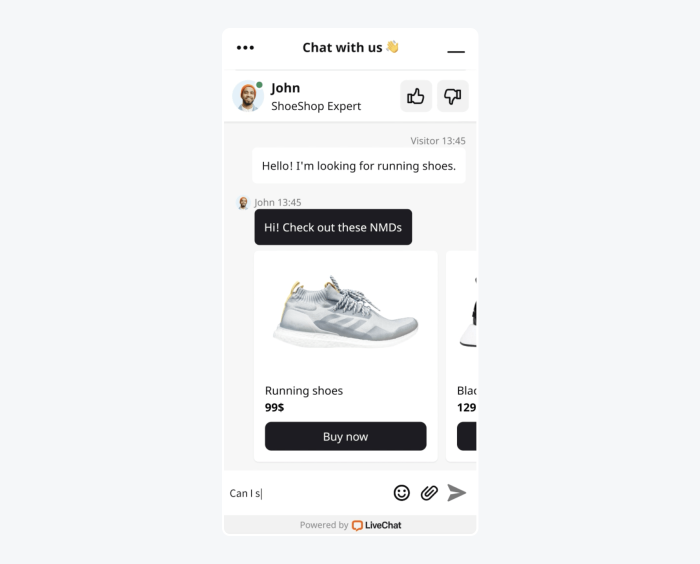
Ratings: 4.5/5 ⭐️ (735+ reviews)
This customer service software for ecommerce provides exactly what the name suggests—live chat. It offers full customization of the chat widget with themes, positioning, and colors. You can create your own customer segments and use a ticketing system for better organization and personalization of support. LiveChat lets you put the chat on multiple customer service channels, such as WhatsApp, Telegram, and Slack, so your online shoppers can contact you from wherever they are.
Pros:
- Chat rating for interactions
- Analytics and reports for agents’ performance and customer satisfaction
- Mobile app for Android and iOS
Cons:
- Limited number of customer allowed in a queue with other clients redirected to other channels
- Some users say there are frequent technical glitches
- Starter ($19/mo/agent)
- Team ($39/mo/agent)
- Business ($59/mo/agent)
- Enterprise → contact sales
3. Gorgias
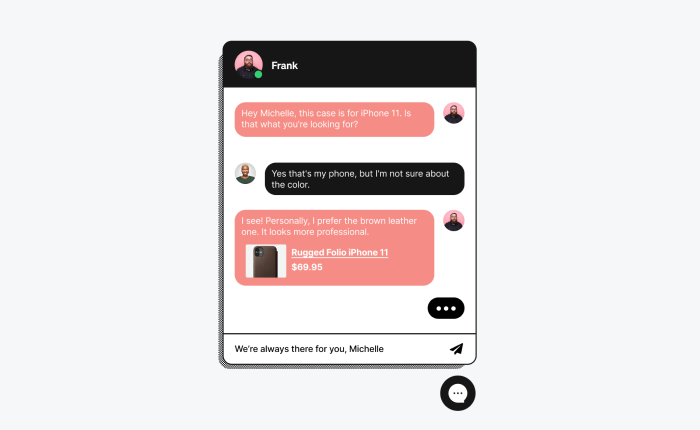
Ratings: 4.6/5 ⭐️ (420+ reviews)
Gorgias is a help desk software that combines a ticketing system with the capabilities of chatbots. It lets you track and segment your audience to offer a more personalized approach to the interactions. It also provides a chatbot history view to learn from previous experiences and easily scale up your customer service efforts. This customer service ecommerce tool helps you to manage conversations using macros and tags.
Pros:
- Extensive training during onboarding
- Order management
- AI intent and sentiment detection tools available
Cons:
- Spam filters need improvements
- Limited reporting available
- Basic ($60/month)
- Pro ($360/month)
- Advanced ($900/month)
- Enterprise → contact sales
Read more: Check out the battle of two powerful AI, Lyro vs Ada CX, and discover how they compare. Also, discover the best Gorgias alternatives and choose the right one for your business.
4. Yieldify
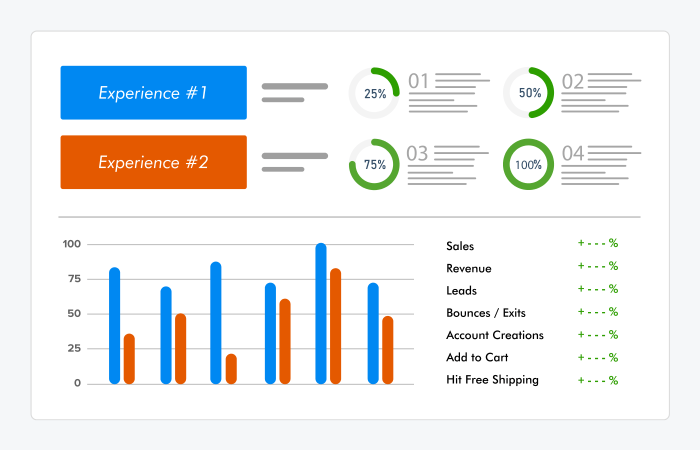
Ratings: 4.7/5 ⭐️ (110+ reviews)
This ecommerce customer service software helps you with personalization and providing custom experiences to your shoppers. It offers in-depth performance metrics and extensive predictions for your online store. You can benchmark your results against competitors and make better business decisions in the future. Yieldify also provides an easy-to-use dashboard to boost your personalization and increase revenue from your online business.
Pros:
- Extensive testing, measurements, and predictions
- Variety of integrations including Google Analytics, Shopify, and Klaviyo
- AI-driven A/B testing
Cons:
- Customers mention that occasionally dashboards stop working
- Technical limitations, such as fixed templates for campaigns and limited number of products to display when sending out email marketing
- Custom pricing → contact sales
5. Yext
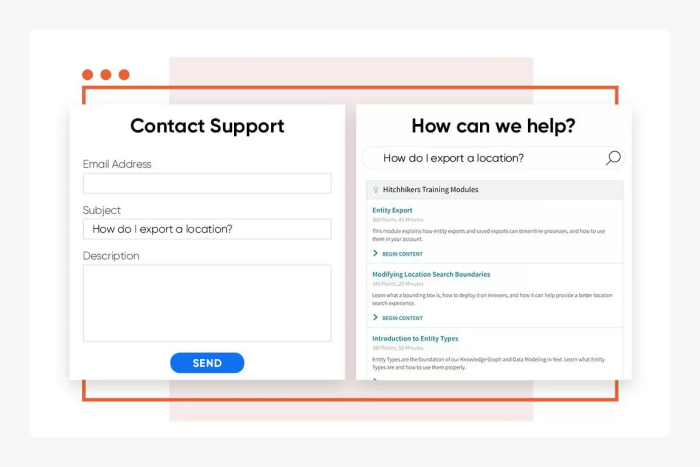
Ratings: 4.4/5 ⭐️ (290+ reviews)
Yext is a little different from the other customer service tools for ecommerce business listed above. It is a search-as-a-service platform that provides an AI-powered search experience for your customers. It uses natural language processing (NLP) to understand customer queries and draws from the company’s resources, including articles, manuals, and FAQs to find answers that best support the client.
Pros:
- Agent desktop search
- In-app support
- Helps with SEO of your help pages
Cons:
- Not much training nor onboarding material provided
- Sometimes the changes don’t appear in the listings
- Custom pricing → contact sales
Read more: Discover different types of customer service software and the ten best tools to use for your business.
How to choose the best ecommerce customer service tool for your business?
There are over 5,000 customer service tools listed on G2, so how are you supposed to choose the right one for your online store? Don’t worry, we got you covered.
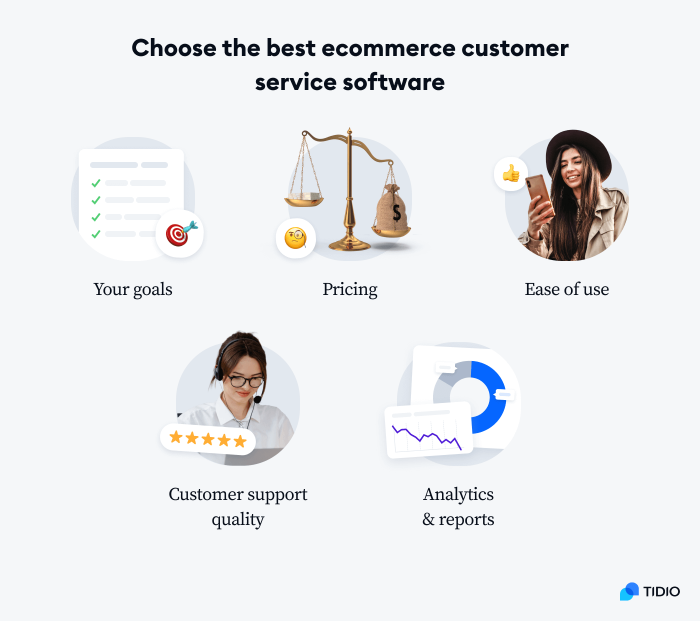
To choose the best software for your ecommerce customer service you should:
- Consider your goals with the software—build a list of must-haves and desired outcomes
- Compare pricing with your budget—weigh up the pricing of different ecommerce customer service platforms and how much value for money you’ll get with each provider
- Ensure it is easy to set up and use—look for a solution that is easy to understand and if you need to employ someone to set the tool up for you, that’s a red flag
- Check the quality of customer support—check Capterra and G2 for user ratings and reviews of the quality of service provided by the supplier
- Look for analytics and reports—choose a platform that offers reports and analytics features to stay on top of your results and know how your customer service is performing
Key takeaway
That was a lot of information in one place. So, let’s do a recap of the most important things for you to remember.
Ecommerce customer service is a way for online businesses to communicate with their shoppers. It usually spans a variety of support channels, such as web chat, social media, and messaging platforms.
To improve your ecommerce support, you should:
- Provide multichannel communication
- Be available 24/7
- Train your representatives
- Enable self-service
- Personalize the experience for the client
- Collect feedback
- Offer proactive service
- Speed up your response time
- Collect and track your data
- Use customer service tools
Remember to tailor the ecommerce service to your shoppers and stay true to your brand. Great support is essential for you to grow, but don’t lose your company’s identity in trying to follow guidebooks.
FAQ
What is ecommerce customer service?
Ecommerce customer service is the support and assistance that online businesses provide to their customers. It includes solving issues, giving advice during the purchase decisions, and helping out in finding the right products quicker. Online stores can assist their shoppers across different channels and platforms to make it more convenient for the buyer and create a seamless multichannel communication experience.
What is the role of customer service in an online store?
The role of ecommerce service in online stores is to answer customer queries, assist shoppers in their buying decisions, and resolve any issues.
Why is customer service important for ecommerce businesses?
Customer service is essential for ecommerce businesses because it can help you increase sales, boost customer retention, and improve the trustworthiness of your online store. It also helps online stores promote their products as well as reach a wide range of potential customers via a variety of channels and platforms.
How to create customer service for ecommerce?
To create customer service for ecommerce you need to be available to your customers on multiple channels and platforms. Your customers should also be able to connect with you from your website at any hour of the day and night.
How to improve customer service in ecommerce?
To improve customer service for an ecommerce business, you should:
- Offer multichannel 24/7 customer service
- Enable self-service
- Personalize the customer experience
- Increase your response time
- Measure results and optimize your efforts
How much does ecommerce customer service outsourcing cost?
Outsourcing ecommerce customer service can cost between $700 and $17,000 per month depending on the agency and services you choose. Some providers offer chat agents you can hire and pay $1/hour, just like Tawk.to. Other outsourcers will charge you management fees and service costs for which you might end up paying thousands of dollars.
While your outsourcing customer service comes with costs, it can still be easier and cheaper compared to building your own in-house.
What is an ecommerce customer experience?
Ecommerce customer experience refers to all the interactions, touchpoints, and feelings your shopper has with your business. It is the experience the buyer has with your business that determines their opinion of your brand and whether they’ll shop with you again or not.

